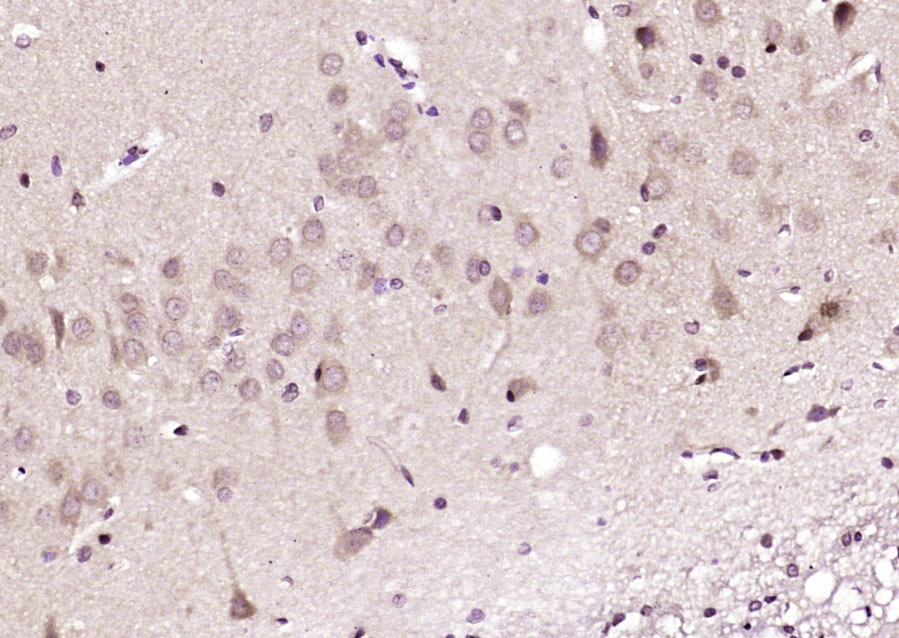
Rabbit Anti-Prickle antibody
FLJ31627; FLJ31937; MGC138902; MGC138903; EPM1B; Prickle 1; Prickle homolog 1 (Drosophila); Prickle like protein 1; Prickle-like 1; Prickle1; REST-Interacting LIM Domain Protein; REST/NRSF interacting LIM domain protein 1; RILP; PRIC1_HUMAN.
View History [Clear]
Details
Product Name Prickle Chinese Name 刺痛感蛋白抗体 Alias FLJ31627; FLJ31937; MGC138902; MGC138903; EPM1B; Prickle 1; Prickle homolog 1 (Drosophila); Prickle like protein 1; Prickle-like 1; Prickle1; REST-Interacting LIM Domain Protein; REST/NRSF interacting LIM domain protein 1; RILP; PRIC1_HUMAN. Research Area transcriptional regulatory factor Zinc finger protein Epigenetics Immunogen Species Rabbit Clonality Polyclonal React Species Rat, (predicted: Human, Mouse, Dog, Pig, Cow, Horse, Sheep, ) Applications ELISA=1:5000-10000 IHC-P=1:100-500 IHC-F=1:100-500 ICC=1:100-500 IF=1:100-500 (Paraffin sections need antigen repair)
not yet tested in other applications.
optimal dilutions/concentrations should be determined by the end user.Theoretical molecular weight 94kDa Cellular localization The nucleus The cell membrane Form Liquid Concentration 1mg/ml immunogen KLH conjugated synthetic peptide derived from human Prickle: 551-650/831 Lsotype IgG Purification affinity purified by Protein A Buffer Solution 0.01M TBS(pH7.4) with 1% BSA, 0.03% Proclin300 and 50% Glycerol. Storage Shipped at 4℃. Store at -20 °C for one year. Avoid repeated freeze/thaw cycles. Attention This product as supplied is intended for research use only, not for use in human, therapeutic or diagnostic applications. PubMed PubMed Product Detail Prickle1 is an 831 amino acid protein that contains one PET domain and three LIM zinc-binding domains and localizes to the cytoplasm, as well as to the nuclear membrane. Expressed at higher levels in placenta and at lower levels in liver, brain, kidney, lung and pancreas, Prickle1 is thought to function as a nuclear receptor that interacts with NRSF, a silencer protein that binds the DNA sequence element NRSE (neuron-restrictive silencer element). Defects in the gene encoding Prickle1 are associated with autosomal recessive progressive myoclonic epilepsy-1B, which is characterized by quick jerks of the arms, shoulders or legs. The gene encoding Prickle1 maps to human chromosome 12, which encodes over 1,100 genes and comprises approximately 4.5% of the human genome.
Function:
Prickle is a LIM domain protein that appears to serve as a nuclear receptor for REST/NRSF, REST4, and possibly other transcription factors. The human protein is a 831 amino acid protein containing 3 N-terminal LIM domains and 3 C-terminal nuclear localization signals. It also contains 4 N-glycosylation sites, 2 PKA phosphorylation sites, and a C-terminal CIIS prenylation motif.
Subunit:
Interacts with REST.
Subcellular Location:
Nuclear Membrane
Tissue Specificity:
Expressed at highest levels in placenta and at lower levels in lung, liver, kidney and pancreas. Expressed in thalamus, hippocampus, cerebral cortex, and cerebellum (in neurons rather than glia).
DISEASE:
Defects in PRICKLE1 are the cause of progressive myoclonic epilepsy type 1B (EPM1B) [MIM:612437]. EPM1B is an autosomal recessive disorder characterized by myoclonus that progresses in severity over time, tonic-clonic seizures and ataxia.
Defects in PRICKLE1 may be a cause of susceptibility to neural tube defects (NTD) [MIM:182940]. Congenital malformations of the central nervous system and adjacent structures related to defective neural tube closure during the first trimester of pregnancy. Failure of neural tube closure can occur at any level of the embryonic axis. Common NTD forms include anencephaly, myelomeningocele and spina bifida, which result from the failure of fusion in the cranial and spinal region of the neural tube. NTDs have a multifactorial etiology encompassing both genetic and environmental components.
Similarity:
Belongs to the prickle / espinas / testin family.
Contains 3 LIM zinc-binding domains.
Contains 1 PET domain.
SWISS:
Q96MT3
Gene ID:
144165
Database links:Entrez Gene: 144165 Human
Entrez Gene: 106042 Mouse
Omim: 608500 Human
SwissProt: Q14C83 Human
SwissProt: Q96MT3 Human
SwissProt: Q3U5C7 Mouse
Unigene: 524348 Human
Unigene: 150314 Mouse
Unigene: 86665 Rat
Product Picture
Bought notes(bought amounts latest0)
No one bought this product
User Comment(Total0User Comment Num)
- No comment



 +86 571 56623320
+86 571 56623320
 +86 18668110335
+86 18668110335

